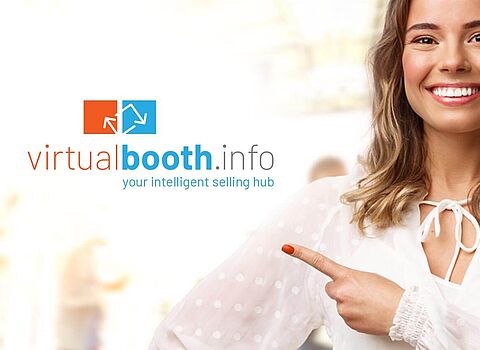Corona has massively slowed down important business events such as meetings, conferences and especially larger trade fairs. Corresponding events often had to be cancelled altogether or, as a study by the Institute for Production Management (IPM) reveals, they were cancelled by up to 65 percent of the companies that would otherwise have participated. Since trade fairs are very important instruments for marketing, sales contact and ultimately for particularly effective customer acquisition and loyalty on the customer journey in many companies, the cancellation of specific industry events represents a considerable problem. The virtual trade show has emerged as a viable solution.
During the second lockdown, at the beginning of 2021, more than three-quarters of the companies surveyed were already participating in major trade fairs online, according to the IPM study. The popularity is growing continuously - not least because a virtual trade fair actually has various significant advantages over a presence trade fair. However, these benefits can only be fully exploited if organisers plan online events in a very differentiated manner.
If you too are asking yourself "How do I organize and create a virtual trade fair stand?" and would like to know what advantages a trade fair in the digital space can offer you, you have come to exactly the right place.
What are the advantages of a virtual trade fair compared to a presence trade fair?
In our article Virtual trade fair - advantages and disadvantages of digital events for companies, you will get a detailed overview of the many advantages of online trade fairs. However, the following factors are also of great advantage:
Organizing virtual events is budget-friendly.
In contrast to classic trade fairs, conferences, etc., there are no costs for travel, accommodation and catering. There is also no need for stand rental, the production of physical advertising and marketing material, the transport of trade fair equipment or trade fair construction.
Personnel resources can be saved considerably. No team is needed for set-up and dismantling, participants do not have to be welcomed and registered on site - this is already done during the registration process that takes place in advance - and generally fewer sales or marketing staff are needed in the running of a virtual trade fair.
The virtual trade fair offers many possibilities that also make modern online marketing so strong. Visitor tracking or KPI reporting, digital selling and the direct connection of other business-critical applications, such as marketing automation, via which lead profiling and lead nurturing via email marketing can be carried out without great effort, are just a few examples.
Schedule virtual events:
Welche verschiedenen Anbieter und Möglichkeiten zur Umsetzung gibt es?
Basically, every trade fair that takes place as a face-to-face event can also be held online. However, this requires the right digital platform.
In order to be able to highlight the perfect virtual trade fair platform, the topic and the goal of the event should first be determined. Only when both are in place, can the acquisition of service providers for the trade fair be taken care of. On a technical level, it is important to consider that virtual trade fairs can have a wide variety of forms online: For example, they exist including interactive fairgrounds in 3D with very many visitors and unique opportunities for interaction or as rather simple 2D events on a smaller scale. The chosen software should of course be able to ideally serve the targeted orientation framework.
In addition to the scope of the trade fair online, at least one landing page is needed to advertise the event and handle registration. Here, too, platforms for digital trade fairs offer different possibilities.
Another very important technical aspect concerns the collection and analysis of data. Virtual trade fairs offer a variety of possibilities for tracking visitors as well as collecting feedback, placing polls and similar. Based on such information, organizers can precisely record whether the trade fair was a success or not. The data can also be used very effectively for further marketing and sales purposes online. Consequently, the virtual booth platform of choice should have the best analytics prerequisites for its own goals.
Thevirtual booth platform reliably covers these central requirement areas.
What are the basics for organizing a virtual trade fair?
Regardless of whether it is a presence trade fair or a virtual trade fair - the correct planning of such events always has a decisive influence on their success.
The following three factors form the basis for planning.
For both real and virtual events, defining the goal is one of the central planning aspects. Only those who really know what is to be achieved can build a trade fair efficiently on these plans.
The goal represents an important support for the complete planning and likewise the execution of the event. Care should be taken to set smart goals, i.e. goals that are realistic, specific, scheduled and measurable.
The goal of the trade fair in turn largely determines its concept - and this must be established before tools or service providers are selected with which organizers organize virtual events.
When it comes to conceptual design, the large number and range of variations of a virtual trade fair platform can seem overwhelming at first. However, if there is a concrete objective and thus a direction in which the digital trade fair should go, it is much easier to draw up the concept.
Before the virtual event is further organized, one's own target group should be the focus of the planning. The central questions here are: How Internet- and technology-savvy are the target persons - do they already have in-depth experience with conference tools and virtual trade fairs or rather not?
Creating clarity here is very important, among other things, in order to be able to perfectly align the usability of the digital event. Less digitally experienced participants need more support and an overall simpler trade fair approach. Whereas visitors who may come from the digital industry themselves should be offered a much more complex experience in order to convince and inspire sufficiently.
This is how the digital trade fair becomes a success!
Virtueller Messestand organisieren in 9 Schritten
Once the planning basics have been fulfilled, it's time to organize the virtual trade fair stand. Experience has shown that adhering to the following 9 steps increases the chances of success enormously.
- Fix the program: Once the goals are clear, the concept is in place and it is known what the target group needs, the program for the trade fair must be defined.
- Acquire partners and guest speakers: Special events, such as lectures or tutorials, are important - because convincing - components of trade fair appearances. Corresponding persons should be acquired at the latest after the conception.
- Create virtual trade fair stand: Only now is the virtual trade fair stand created with all its features.
- Invite visitors: Now visitors have to be won over, which can be done online in various ways. Typically, one creates a guest list of known people and contacts them directly.
- Specific marketing helps to reach out to more target customers as well. Everyone signs up through a landing page created specifically for the event.
- Brief the team: The trade fair team is now briefed precisely - this concerns both the behaviour at the virtual trade fair and its technology.
- Preliminary testing: Before the virtual trade fair actually goes online, all features should be thoroughly tested. If there are perhaps massive deficits that only become apparent in the course of the event, this casts a very negative light on the organizer.
- Carry out the event: The digital trade fair is now ready for the visitors. Virtual presentations, interaction, moderation and, at best, sales take place. However, technical staff should always be on hand to quickly remedy any problems.
- Follow-up: When the event is over, there is usually a lot of data that needs to be evaluated and processed. It is still necessary to play out follow-ups, collect feedback and generally check the achievement of the trade fair goals.
What else needs to be considered?
In practically every industry, a trade fair can certainly also take place in the digital space. However, the event concept of a presence trade fair cannot normally be "virtualised" one-to-one. Therefore, a special concept for the online medium should always be chosen.
- Not every visitor is familiar with digital events. Therefore, participants - especially in typically less digitally affine industries - should be supported as much as possible during their visit to the trade fair. In general, it is important to make the entire event as user-friendly as possible. Providing information in advance about how the trade fair will proceed via a program is always beneficial here.
- It should be noted that the attention of trade fair participants is different in front of the screen than on site at a real trade fair. Visitors sometimes cannot concentrate on one thing for as long on the computer or are simply less willing to do so. Therefore, shorter sessions and longer breaks should be planned for virtual trade fairs.
- A good picture and the best sound are absolutely crucial for success at a virtual trade fair on all levels concerned. For example, the chances of a conclusion in a personal conversation via video meeting dwindle enormously if the sound is transmitted in a choppy manner and/or the picture hangs again and again.
- Another topic that must be given special attention is data protection: The topic of data protection. Just like on a website, the user's data must be protected and, according to the DSGVO, explicit consent must be obtained from the user before this data can be stored or used in any form. Especially with regard to subsequent marketing activities, such as email marketing, lead management or marketing automation, this is a point that must not be ignored.
What does a virtual trade fair cost?
Of course, it is not possible to say across the board how much a virtual trade fair costs. That depends on various factors. First of all, you should look at which features are needed for the trade fair or to achieve the trade fair goal.
Centrally important here is answering the question:
- What experiences and interaction options should visitors get?
- Should the trade fair take place in 2D or even in 3D?
- Will a live event take place, for example in the form of a webinar?
- Is the connection to a marketing automation system also required?
Furthermore, the targeted number of participants is an important cost factor. Many providers of a virtual trade fair platform stagger their prices based on the expected connections with their solution. This approach is only logical, because a digital platform that has to organize 100 visitors, for example, requires far fewer resources than one that has to manage 20,000 participants.
In general, a virtual event can be hosted for as little as around €4,900. However, most providers of software for virtual trade fairs do not have a fixed price list. Interested parties have to inquire and will then receive an individual calculation. Usually, a free demo can be booked at this point, in the course of which a guided tour takes place and all important functions are explained.
Conclusion
As a typical trade fair company, you probably already know the basics of event planning. A virtual trade fair allows you to build on these and at the same time expand your know-how bit by bit through the new options of the digital platform. Good tools not only offer you many features, but also provide concrete help in using them via a customer-oriented service.
After all, you can integrate practically all processes into your virtual trade fair that also give you advantages at a presence trade fair. At the same time, the online presence offers you numerous simplifications and technical possibilities that you do not have at a conventional trade fair. Thus, the virtual trade fair is much more than a stopgap solution - it is a modern alternative to the classic event.
Our support around the topic of virtual trade fairs to increase the efficiency of your digital sales:
- We support you in the conception of your individual and success-oriented trade fair strategy - according to your intended goals and target groups.
- In addition to the professional implementation of your digital trade fair stand with our virtualbooth tool, we show you how you can benefit from optimal data utilisation.
- Make sustainable use of your digital trade fair stand by not only generating leads, but also developing them into customers in a targeted nurture process at the appropriate points of the customer journey - our experts are happy to help!
- Of course, we will work with you to ensure DSGVO-compliant implementation and will be happy to advise you in this regard as well.
For your holistically successful digital sales, we are also happy to support you around these topics:
Oliver Parrizas will be happy to answer any questions you may have on the subject. +49-800-911-91-91













